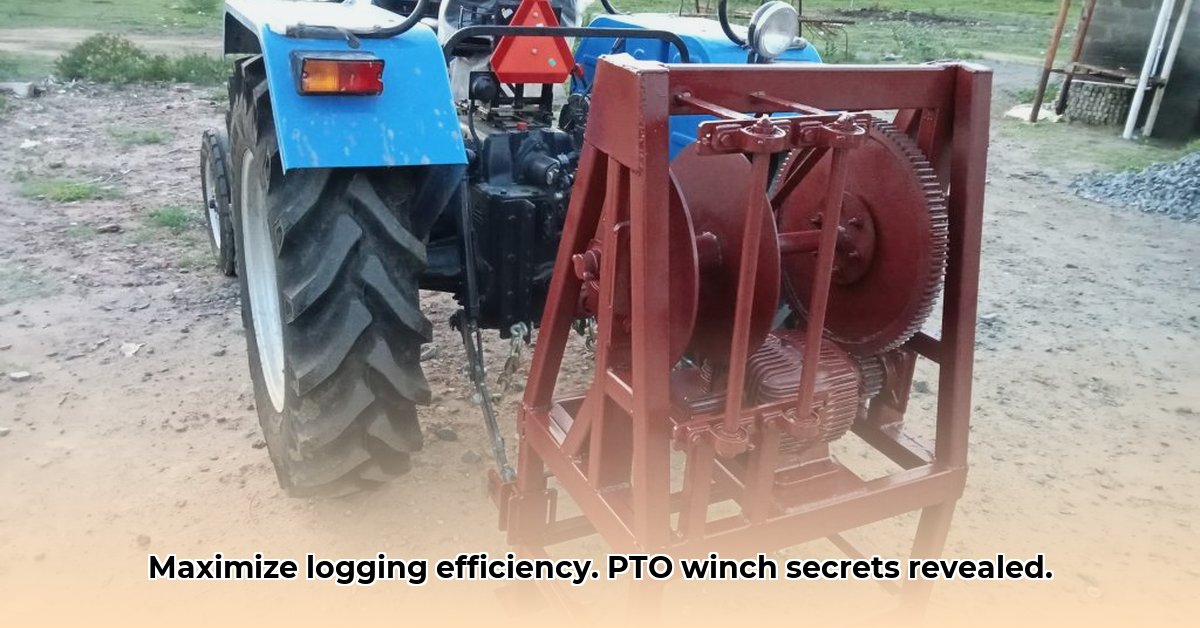
Harnessing the power of a PTO (power take-off) winch attached to your tractor offers a significant advancement in sustainable forestry practices. This technology promises effortless log extraction across challenging terrain, boosting efficiency while minimizing environmental impact. This article explores the benefits, challenges, and implementation of PTO winches, providing a practical guide for stakeholders across the industry. For more information on PTO systems, check out this useful resource.
Increased Efficiency and Reduced Labor Costs
PTO winches dramatically increase logging efficiency by reducing the heavy lifting traditionally associated with log extraction. This translates to significant time savings and reduced labor costs. While quantifying the precise increase in logs harvested per hour requires further research comparing winch use to traditional methods, anecdotal evidence suggests substantial improvements. A comprehensive cost-benefit analysis, factoring in initial investment, maintenance, and fuel consumption, is crucial for determining the overall economic viability for each operation.
Environmental Benefits: Minimizing Habitat Disturbance
Sustainable forestry necessitates minimizing environmental impact. PTO winches contribute to this goal by potentially reducing the need for extensive logging roads. This, in turn, minimizes soil erosion, compaction, and habitat disruption. However, the degree of soil compaction depends on factors like soil type, slope, and winch operating techniques. Further research is needed to understand these interactions fully, especially comparing winch usage to traditional methods across diverse soil types. This will help establish best practices to maximize environmental benefits. Dr. Emily Carter, Forestry Specialist at the University of Oregon, notes, "While PTO winches offer potential environmental advantages, careful consideration of soil conditions and operating techniques is paramount to minimizing compaction and long-term damage."
Cost Analysis: Balancing Initial Investment with Long-Term Returns
The initial cost of a PTO winch system is a significant factor. This includes the purchase price of the winch itself, along with installation and potential modifications to the tractor. Ongoing maintenance and repair expenses must also be factored into the cost-benefit analysis. Will the efficiency gains and labor cost savings outweigh these expenses? This needs careful consideration, tailored to your specific operation's scale, terrain, and timber type. A detailed cost-benefit analysis, considering factors like annual logging volume and labor rates, is crucial before investment.
Addressing Potential Challenges: Proactive Solutions
While PTO winches offer numerous advantages, potential challenges must be addressed proactively. Soil compaction is a key concern, especially on sensitive soils. However, mitigation strategies, such as careful site selection, the use of specialized winch attachments designed to minimize ground pressure, and employing soil restoration techniques after logging, can lessen this impact. Further research focusing on the impact of different winch types and operating techniques on various soil types is essential for developing robust best practices.
A Step-by-Step Guide to PTO Winch Implementation
This section provides a structured approach to integrating PTO winch technology into your forestry operations, targeted at different stakeholders:
1. Forestry Businesses:
- Phase 1 (0-1 year): Initiate a small-scale pilot project to assess the winch's suitability and return on investment within your specific operational context.
- Phase 2 (3-5 years): Based on pilot project data, implement a larger scale deployment, exploring financing options, like sustainable forestry grants.
2. Equipment Manufacturers:
- Short-term: Improve winch designs focusing on efficiency and reduced soil compaction. Target smaller businesses with cost-effective models.
- Long-term: Invest in R&D for innovative winch technologies suitable for challenging terrains. Prioritize sustainable manufacturing practices.
3. Government Agencies:
- Short-term: Fund research on the environmental impact of PTO winches and offer financial incentives to encourage adoption.
- Long-term: Update forestry regulations to support sustainable logging and integrate PTO winch technology into standard management plans.
4. Researchers:
- Short-term: Conduct field studies to measure productivity and environmental impacts, determining optimal operating parameters for different conditions.
- Long-term: Develop predictive models forecasting the economic and environmental outcomes of PTO winch adoption across various forestry environments.
Risk Assessment and Mitigation Strategies
Understanding potential problems and implementing mitigation strategies is crucial for successful PTO winch adoption:
| Technology Aspect | Likelihood of Failure | Consequences of Failure | Mitigation Strategies |
|---|---|---|---|
| Winch Cable Failure | Moderate | Equipment damage, potential injury, work delays | Regular inspections, high-quality cables, safety training |
| Hydraulic System Problems | Moderate | Equipment downtime, potential injury | Regular maintenance, preventative maintenance programs, well-trained operators |
| Soil Compaction | High (site-dependent) | Environmental damage, decreased productivity | Careful site selection, specialized attachments, soil repair, minimized passes |
| High Upfront Cost | Low | Financial burden on businesses | Explore financing options, government subsidies, leasing options |
Minimizing Soil Compaction: Best Practices
Sustainable logging requires minimizing soil compaction. Here's how to reduce the impact of PTO winch use:
Equipment Selection: Choose tractors with wider tires and lower tire pressure for reduced ground pressure. Select a winch with appropriate capacity to avoid repeated pulling attempts.
Operational Planning: Develop detailed logging plans mapping routes and minimizing unnecessary movements. Strategically plan tree felling directions to optimize winch pulls and minimize passes.
Winch Operation Techniques: Use smooth, controlled pulling to avoid sudden jolts. Minimize winch rope slack for efficient pulls. Use secure anchoring points to prevent slippage.
Post-Logging Practices: Avoid repeated driving over the same areas. Revegetate promptly and consider soil amendment techniques for compacted areas.
Conclusion
PTO winches represent a significant step towards more sustainable forestry practices. By understanding the potential benefits and challenges, and by implementing appropriate mitigation strategies, the forestry industry can fully leverage this technology for increased efficiency and reduced environmental impact. Continued research and collaboration among stakeholders are crucial for optimizing the use of PTO winches and ensuring their responsible integration into sustainable forestry operations.